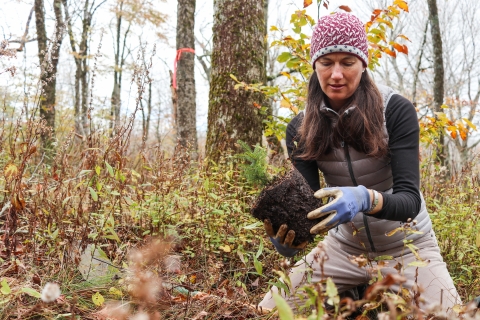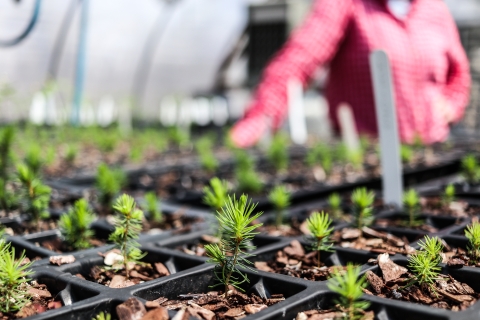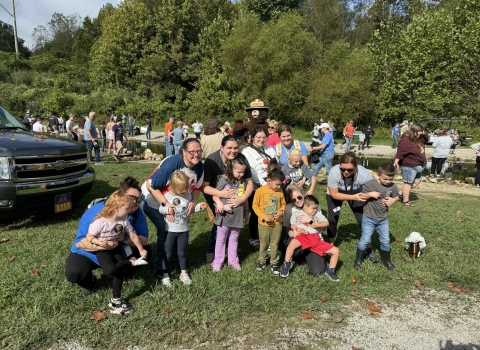Asheville, North Carolina — As a thunderstorm brought torrential rain and a power outage, Kelly Holdbrooks helped load 250 young red spruce trees onto a trailer. Holdbrooks had helped raise the trees from seed at Southern Highlands Reserve, a non-profit arboretum and research center outside Brevard, N.C. Once the trees were loaded, U.S. Forest Service staff climbed into the truck and pulled out, with Holdbrooks and U.S. Fish and Wildlife Service biologist Sue Cameron looking on as the trees departed for the Cherokee National Forest last fall.
Two days later, a heavy frost covered Tennessee’s Whigg Meadow as Cameron stood near the tree-loaded trailer. She gave instructions on how to plant the trees before staff from three agencies and a class of university students set to planting them beneath the sparse beech and birch canopy. By early afternoon, the spruce were in the ground, bringing an end to the planting season, and closing the latest chapter in an ambitious effort to increase red spruce in the southern Appalachians. It is an ambitious effort spearheaded by four women brought together by a commitment to the highest peaks east of the Mississippi River.
Southern Appalachian spruce trees arrived with the last ice age. As temperatures dropped and inhospitable ice sheets covered northern latitudes, cold-climate plants and animals migrated south. As temperatures warmed at the end of the ice age, those plants and animals followed the cold weather, migrating back north … and uphill. The southern Appalachians are home to the highest peaks in the eastern United States, and these mountaintop areas created a refuge for cold weather species typically found further north, including red spruce. Common from New York into Canada, red spruce live on a scattering of high-elevation sites down the spine of the Appalachian Mountains, with North Carolina’s Balsam Mountains marking the southern extent.
“It’s amazing that you can travel a few miles from Asheville and basically go to a place that feels like Canada,” said Cameron.
During the first two decades of the 20th century, the southern Appalachians saw extensive industrial-level logging, including in the high-elevation forests with red spruce. This was followed by rampant wildfires that consumed the organic soil red spruce seeds need to take root. The logging knocked back the extent of the spruce forests, then the fires checked their return.
Rising to the challenge
Christine Kelly, Chris for short, is a biologist with the North Carolina Wildlife Resources Commission (NCWRC), and the state’s point person on the Carolina northern flying squirrel — an endangered species found only on the highest peaks of the southern Appalachians. That squirrel turned out to be a big motivator in getting Kelly engaged with southern Appalachian spruce restoration. The squirrel feeds on a fungus, or truffle, that grows among the roots of the red spruce tree. The tree’s branches also provide nesting sites for the animal. Essentially, more spruce trees means more food and shelter for the squirrel. More food and shelter, more squirrels. While the squirrel may be the most high-profile creature to benefit from more red spruce, there are plenty of others, including the red crossbill and the endangered spruce-fir moss spider.
Another factor that led to Kelly’s involvement? The challenge raised when a fellow biologist lamented that people had been talking about restoring spruce for 30 years and no one had done anything about it.
“My first thought was, ‘Think how far along we’d be if someone had started 30 years ago.’ ” Kelly said. “My second thought was ‘With my job, I’m in a good place to initiate such an effort.’”
The year 2009 was pivotal. Kelly attended a spruce restoration conference in West Virginia, learning from the active restoration effort in the central Appalachians. She also met the director of the Southern Highlands Reserve and realized the non-profit could meet a key need – they had been raising spruce for years, which no one else was doing in the southern Appalachians. Also that year, Sue Cameron left her job as a bird biologist with the NCWRC to join the Service’s Asheville field office. Her responsibilities included coordinating efforts to recover the Carolina northern flying squirrel, which brought her into the spruce restoration effort.
Meanwhile, on the Tennessee side of the mountains, The Nature Conservancy’s Katherine Medlock was working with the Cherokee National Forest on restoration efforts, and red spruce was proving a challenge. No one had experience restoring red spruce, and they didn’t know where to get the actual trees to plant. Conversations led her to Kelly and Cameron, and between the three of them it became evident there were a lot of people across the region interested in spruce restoration. The question was just how much interest was there, and could it be harnessed and converted to action? To figure that out, they put out an invitation for anyone interested to convene in Asheville for a day.
One person in attendance at that pivotal Asheville meeting was Kelly Holdbrooks, who had taken over as director of the Southern Highlands Reserve.
“When I got the email, I thought ‘we need to be a part of this’,” said Holdbrooks. “I knew it had the potential to have a landscape effect on the region, and I wanted Southern Highlands Reserve to be part of that.”
A partnership is born
From that meeting rose the Southern Appalachian Spruce Restoration Initiative, or SASRI – the umbrella partnership that brings together those interested in red spruce restoration and moves the effort forward. It was Medlock who got the organization rolling.
“I served as an ad-hoc facilitator for a while, trying to develop enough structure structure
Something temporarily or permanently constructed, built, or placed; and constructed of natural or manufactured parts including, but not limited to, a building, shed, cabin, porch, bridge, walkway, stair steps, sign, landing, platform, dock, rack, fence, telecommunication device, antennae, fish cleaning table, satellite dish/mount, or well head.
Learn more about structure that the group would persist,” said Medlock. Under Medlock’s leadership, the group developed a red spruce restoration plan, which has guided efforts since.
The partnership is beginning to fall into a rhythm. Spruce cones, full of seeds, have been collected for years now, with the Southern Highlands Reserve raising the trees. To date, nearly 4,000 of their trees have been planted on the landscape, with more than 4,000 more growing at Southern Highlands Reserve.
“My role is to connect the dots between seed collection, propagation, and keeping records on the trees. This allows me to identify the right seedling for upcoming plantings, making certain that the trees being planted in an area originated from seed taken from that area,” said Holdbrooks.
When trees are ready to be planted, sites are identified and labor is mustered for the job. The year 2017 saw two large plantings. One, organized by Kelly, occurred on the Pisgah National Forest, near the popular Graveyard Fields. Staff from the Service, the U.S. Forest Service (USFS), NCWRC; volunteers from the Pisgah Conservancy, Southern Appalachian Wilderness Stewards and area communities; and students from Haywood Community College and Warren Wilson College put 900 trees in the ground. The second was the Whigg Meadow planting, organized by Cameron, which brought out Service, USFS, and Tennessee Wildlife Resources Agency staff, with students from the University of Tennessee.
“The decimation of the spruce forest by unsustainable practices in the early 1900s still needs to be rectified,” said Kelly. “My hope is that this work can fix some of that, that we can shore up this unique ecosystem, even a century after the fact. The flying squirrels have hung on, but face new challenges. It’s important that we provide the best possible habitat for them.”
At home in the forests
While landscape-level forest restoration and the future of an endangered species are significant professional motivators in their own right, for these women there are also profound personal drivers.
“This hits me on a deep, deep level,” said Holdbrooks. “I moved here 18 years ago on a whim, turning down a job at Princeton University, taking a job at Max and Rosie’s Café in Asheville. I was their juice girl. That’s how important this area is to me. There’s something about this area that speaks to me.”
And it’s not all about the outdoors, either.
“One of the things I’ve enjoyed most, on a very personal note, has been getting to know Sue, Chris and Kelly,” said Medlock. “They’re great ladies and they do awesome work — all of them.”






